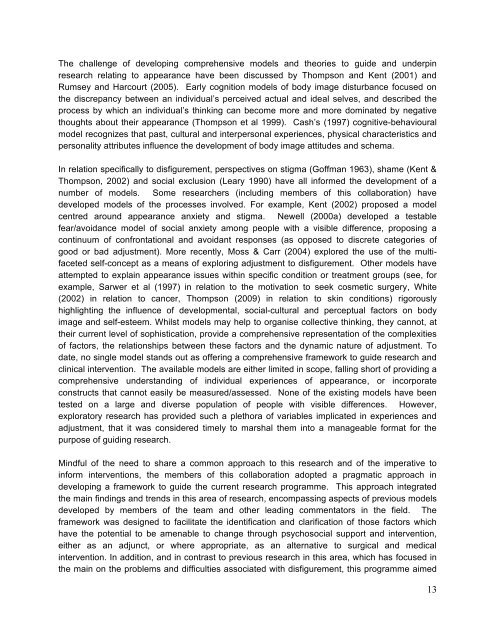Download the report - The Healing Foundation
Download the report - The Healing Foundation
Download the report - The Healing Foundation
You also want an ePaper? Increase the reach of your titles
YUMPU automatically turns print PDFs into web optimized ePapers that Google loves.
<strong>The</strong> challenge of developing comprehensive models and <strong>the</strong>ories to guide and underpin<br />
research relating to appearance have been discussed by Thompson and Kent (2001) and<br />
Rumsey and Harcourt (2005). Early cognition models of body image disturbance focused on<br />
<strong>the</strong> discrepancy between an individual’s perceived actual and ideal selves, and described <strong>the</strong><br />
process by which an individual’s thinking can become more and more dominated by negative<br />
thoughts about <strong>the</strong>ir appearance (Thompson et al 1999). Cash’s (1997) cognitive-behavioural<br />
model recognizes that past, cultural and interpersonal experiences, physical characteristics and<br />
personality attributes influence <strong>the</strong> development of body image attitudes and schema.<br />
In relation specifically to disfigurement, perspectives on stigma (Goffman 1963), shame (Kent &<br />
Thompson, 2002) and social exclusion (Leary 1990) have all informed <strong>the</strong> development of a<br />
number of models. Some researchers (including members of this collaboration) have<br />
developed models of <strong>the</strong> processes involved. For example, Kent (2002) proposed a model<br />
centred around appearance anxiety and stigma. Newell (2000a) developed a testable<br />
fear/avoidance model of social anxiety among people with a visible difference, proposing a<br />
continuum of confrontational and avoidant responses (as opposed to discrete categories of<br />
good or bad adjustment). More recently, Moss & Carr (2004) explored <strong>the</strong> use of <strong>the</strong> multifaceted<br />
self-concept as a means of exploring adjustment to disfigurement. O<strong>the</strong>r models have<br />
attempted to explain appearance issues within specific condition or treatment groups (see, for<br />
example, Sarwer et al (1997) in relation to <strong>the</strong> motivation to seek cosmetic surgery, White<br />
(2002) in relation to cancer, Thompson (2009) in relation to skin conditions) rigorously<br />
highlighting <strong>the</strong> influence of developmental, social-cultural and perceptual factors on body<br />
image and self-esteem. Whilst models may help to organise collective thinking, <strong>the</strong>y cannot, at<br />
<strong>the</strong>ir current level of sophistication, provide a comprehensive representation of <strong>the</strong> complexities<br />
of factors, <strong>the</strong> relationships between <strong>the</strong>se factors and <strong>the</strong> dynamic nature of adjustment. To<br />
date, no single model stands out as offering a comprehensive framework to guide research and<br />
clinical intervention. <strong>The</strong> available models are ei<strong>the</strong>r limited in scope, falling short of providing a<br />
comprehensive understanding of individual experiences of appearance, or incorporate<br />
constructs that cannot easily be measured/assessed. None of <strong>the</strong> existing models have been<br />
tested on a large and diverse population of people with visible differences. However,<br />
exploratory research has provided such a plethora of variables implicated in experiences and<br />
adjustment, that it was considered timely to marshal <strong>the</strong>m into a manageable format for <strong>the</strong><br />
purpose of guiding research.<br />
Mindful of <strong>the</strong> need to share a common approach to this research and of <strong>the</strong> imperative to<br />
inform interventions, <strong>the</strong> members of this collaboration adopted a pragmatic approach in<br />
developing a framework to guide <strong>the</strong> current research programme. This approach integrated<br />
<strong>the</strong> main findings and trends in this area of research, encompassing aspects of previous models<br />
developed by members of <strong>the</strong> team and o<strong>the</strong>r leading commentators in <strong>the</strong> field. <strong>The</strong><br />
framework was designed to facilitate <strong>the</strong> identification and clarification of those factors which<br />
have <strong>the</strong> potential to be amenable to change through psychosocial support and intervention,<br />
ei<strong>the</strong>r as an adjunct, or where appropriate, as an alternative to surgical and medical<br />
intervention. In addition, and in contrast to previous research in this area, which has focused in<br />
<strong>the</strong> main on <strong>the</strong> problems and difficulties associated with disfigurement, this programme aimed<br />
13


